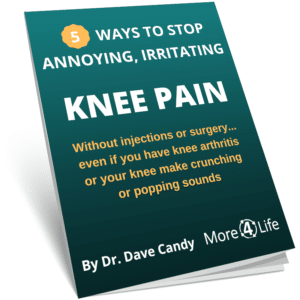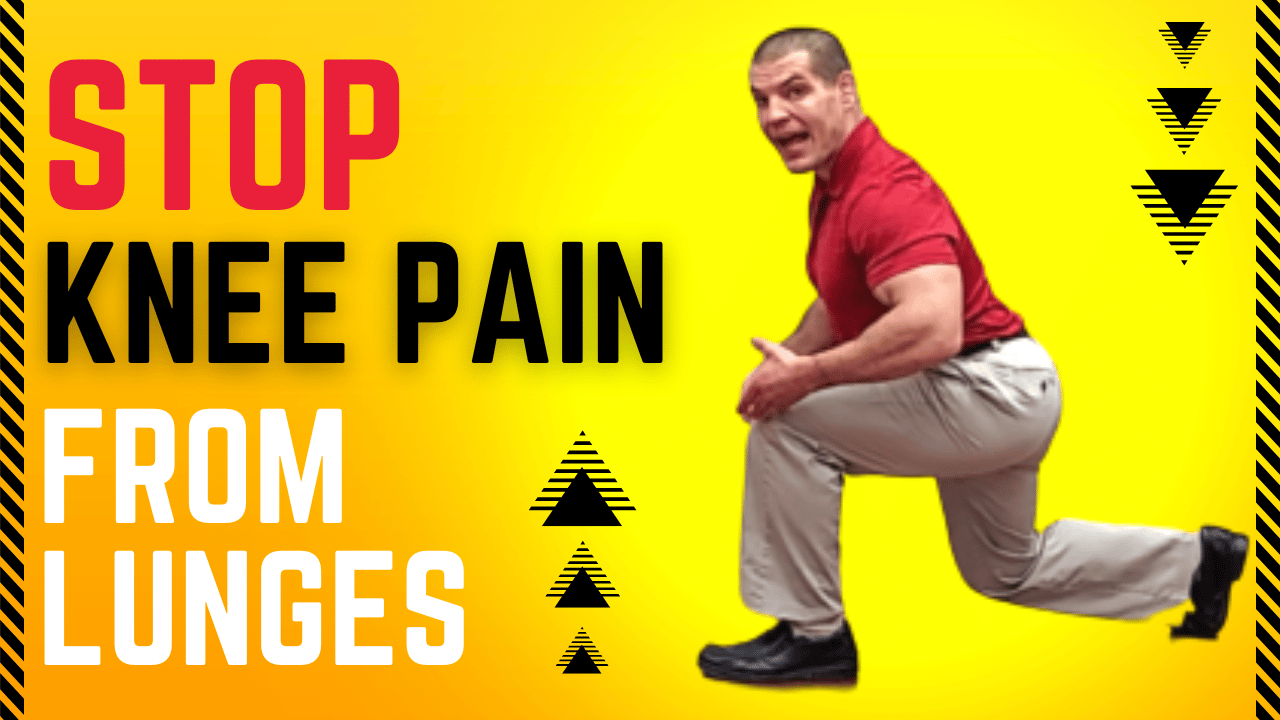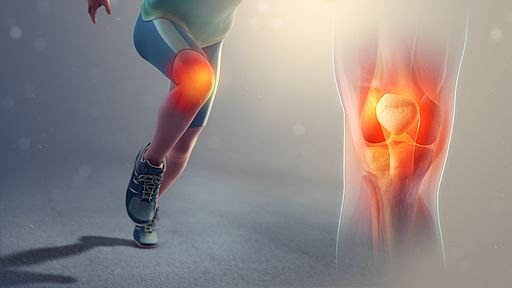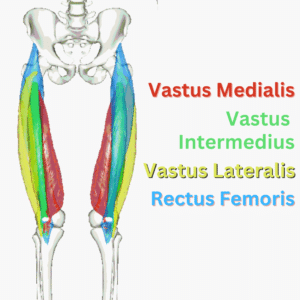Wonder why your knee hurts when doing lunges? Lunges are one of the most hated gym exercises. Try the 2 simple tips in this video to stop knee pain from lunges. Then read the rest of this post to learn 5 more bonus tips to keep your knees from hurting when doing lunges.

Why Your Knee Hurts When Doing Lunges
If your knee hurts when doing lunges either for exercise or just when you're getting up from the floor it can be quite bothersome.
One of the main things that causes knee pain during lunges is compression behind the kneecap where your kneecap compresses on your thigh bone.
This is often referred to as patellofemoral pain. (patella = kneecap, femur = thigh bone)
Normally people will get pain from doing lunges on the front of their knee.
Sometimes it's more of an ache, and other times it can be a sharp, stabbing pain.
That depends largely on how much compression, and to some extent how much cartilage loss there is on the back of the kneecap.
For example, this can happen with knee arthritis, or a milder form called chondromalacia patella.
What Causes Kneecap Compression When Doing Lunges?
People primarily do lunges as a quadriceps exercises. However, it's actually a great total lower body exercises.
In particularly, lunges are a great exercise for your glute muscles.
You use both of those your quads and glutes together when you're doing a lunge.
However depending on HOW you do it can change what proportion of the effort is coming from the quadriceps vs. the glutes.
When you put your weight more toward the toes of your front leg, your quadriceps.
If you put your weight more backwards toward your heel, you use more effort from your glutes.
Your kneecap (or patella) sits inside of your quadriceps tendon, so the more quadriceps force you use, the more your knee hurts when doing lunges.
Additionally, the deeper you go into the lung, the more your quadriceps get stretched over the knee joint.
This too causes more compression of the kneecap on the thigh.
Finally, your kneecap is supposed to move up and down in a groove on your femur as you bend and straighten your knee.
If the kneecap tracks too far to the outside of that groove, it can create compression on the outer edge of the kneecap.
What To Do If Your Knee Hurts When Doing Lunges
So we've discussed the reasons WHY your knee might hurt doing lunges, but now you probably want to know how to stop the pain, right?
Essentially the way to stop knee pain during lunges is just the opposite of the things that cause it.
There are basically 2 main tips to stop knee pain during lunges:
- Keeping your weight more on your heel
- Keeping your knee inline with your toes.
There are a few other things beyond those tips that we'll discuss later in this post, but fixing those two things will take care of most people's problems.
Keep Your Weight More On Your Heel When Doing Lunges
Whether you're doing forward lunges, reverse lunges, or walking lunges where you alternate one foot after the other, you want to try to keep your weight more on the heel of your front foot. Think of it as if you were trying to sit your butt back behind your front heel.
When you keep your weight more on your heel when you're doing your lunge, it uses more of your glutes than your quadriceps.
Additionally, if you keep your weight on your heel, it also prevents your knee from going in front of your toes, causing less knee bending.
When the knee bends less, your quadriceps don't get stretched as much. That also helps decreases the compression force on your kneecap, which equates to your knee hurting less when you do a lunges
Keep Your Knee In Line With Your Toes When Doing Lunges
The first tip had to do more with the front-to-back motion of your knee. This second tip has to do more with the side-to-side motion of your knee when doing lunges.
As mentioned above, your kneecap normally sits in a groove on your thigh bone. If your knee goes too far inward while doing lunges, this causes the thigh to move inward while the knee cap gets compressed on outer edge of that groove, especially if you have a stiff IT Band.
Therefore, it's really important when you're doing lunges to keep your knee in a central alignment and not let it go inside of your toes.
This is probably the most common flaw I see when people do lunges. It has to do with weakness of the hip abductor muscles and the hip rotator muscles.
And the funny thing is, most people who have this problem are completely unaware of it.
Why don't people know they're doing lunges wrong?
Most people don't necessarily think about their technique when doing lunges, they just think about doing the reps they're supposed to while maintaining their balance and not falling over.
Even people that are aware of proper technique though often feel like they're doing lunges correctly when they may not be.
Why, you may ask?
Your eyes are in the middle of your body and your feet are slightly farther out.
So if you look in a direct line from your eyes to your toes, if the knee falls directly in that line, then it's acutally a little bit further toward the midline than your toes are.
In order for your knees to be vertically aligned with your toes, you might have to turn your knees out a little bit more than it feels like you naturally should. It may actually feel like you're a little bit bow-legged.
Your Anatomy Makes A Difference
There is some varience from person to person though.
- Some people are naturally knock-kneed and it's good for their knees to go in just a little bit when doing lunges
- Some some people have knees that point straight ahead, and their knees should also go straight ahead when doing lunges.
- Finally, some people are naturally bow legged, and so their knees REALLY need to go farther out in order to be in proper alignment.
In general though, if your knee hurts when doing lunges, it's more likely that your knees are going too far inward rather than too far outward.
Ultimately though, you need to experiment and find the motion path that works best given your anatomy.
What Do I Do If My Back Leg Hurts While Lunging?
If your back leg hurts while lunging, usually that's due to a flexibility problem in your quadriceps muscles, and particularly a muscle called your rectus femoris.
Your recuts femoris crosses both the hip and knee joints. It functions to extend (straighten) your knee as well as to flex (bend) your hip.
While lunging, the back leg is extended at the hip and flexed at the knee, which puts the rectus femoris on a maximum stretch.
Since your kneecap sits inside your quadriceps tendon, stiffness of your quadriceps can cause patellofemoral pain in the back leg while lunging.
In order to keep your back leg from hurting while lunging, it's a good idea to stretch your quadriceps.
Additionally, if you keep 80-90% of your weight on your front leg, that can also prevent your back leg from hurting while lunging.
If your quad muscles are contracting (trying to shorten) at the same time that your lengthening them, that can create additional compression of the kneecap on your back leg.
More Tips To Stop Your Knees From Hurting Doing Lunges
I mentioned earlier that there are a few more tips besides the ones in the video, so here they are.
Modified Lunges For Knee Pain
As mentioned above, the deeper you go in to a lunge, the more compression it puts on the kneecap.
It also becomes much harder because the deeper you go down, the more force that's required to stand back up. (That's why people often have more difficulty standing up from sitting in a low chair).
So one great alternative is just do do a partial lunge as shown above. Still make certain to keep your weight more on your heel than your toes though. (Note the knee is going in front of the toe in the picture above, which shouldn't happen).
Alternative To Lunges For Knee Pain
If your knee hurts when doing lunges, you may want some alternative leg strengthening exercises to try.
Some people with knee pain don't want to do partial lunges. Maybe their knees may start hurting before their muscles get tired. Or, their doctors may have (mistakenly) told them that lunges are bad for knee pain.
If you do lunges wrong, or if you go to deep, lunges can cause knee pain.
However, if you limit depth and use the tips above, there's no reason that you can't do lunges.
Lunges work one leg at a time, unlike squats, so you strengthen more in the side-to-side direction.
However, if you do want some alternatives to lunges either due to pain or just to mix up your exercise routine a bit, here are a few suggestions.
- Single leg balance - If you really have a lot of knee pain and can't (or don't want to) even do partial lunges, standing on one leg helps you improve the strength of your hip and ankle muscles, both of which affect your knee stability.
- Step ups - During step ups, you still work one leg at a time, but typically you don't have to bend your knee as much. Truly this is probably harder than a partial lunge, but it's a very functional exercise that can help if you have knee pain going up and down stairs.
- Single leg leg press - while leg presses aren't the most functional exercise and don't help your balance like lunges or step ups, they are easier, and you can vary the load to be as heavy or light as you want. Using one leg at a time will help prevent you from using your strong leg to compensate for your weaker leg.
Stretch Your Quadriceps
If your quadriceps are stiff, it creates more kneecap compression both on the front and back knees when doing lunges.
There are 4 quadricep muscles, but the one that is usually problematic is the rectus femoris, which is a knee extensor as well as a hip flexor. Learn 4 different hip flexor stretches here.
Arch Supports & Orthotics
If you have flat feet or your feet overpronate, it can cause your knee to go more inward when doing lunges. This in turn can cause your knee to hurt.
For many people who don't have severe overpronation, over the counter arch support insoles can help.
I would recommend Superfeet green insoles for people with low-to-moderate height arches.
Or if you have high arches, Spenco high-arch insoles help better absorb shock while supporting a high arch.
If you have more severe overpronatation, you may need custom orthotics.
Physical Therapy For Knee Pain
If you've tried these self-help tips and you're still having knee pain doing lunges, you should see a physical therapist about your knee pain.
Our specialist physical therapists help you find out what's causing your knee pain and what you can do to get rid of it.
Our physical therapy is much more than exercises. That's why we give away all of this information for free. Because we believe that physical therapy should be more than just charging you and your insurance for things that you could easily do on your own.
If you'd like one of our specialist physical therapists to help you get rid of your knee pain and learn what to do to keep it from coming back, click the button below to request an appointment.
Like this post? Learn more exercises for knee pain
7 Quad Stretches For Knee Pain
My Knee Hurts From Squats! 4 Ways To Stop Knee Pain With Squats
Hamstring Stretches To Relieve Tight, Stiff Muscles In Back Of Leg








